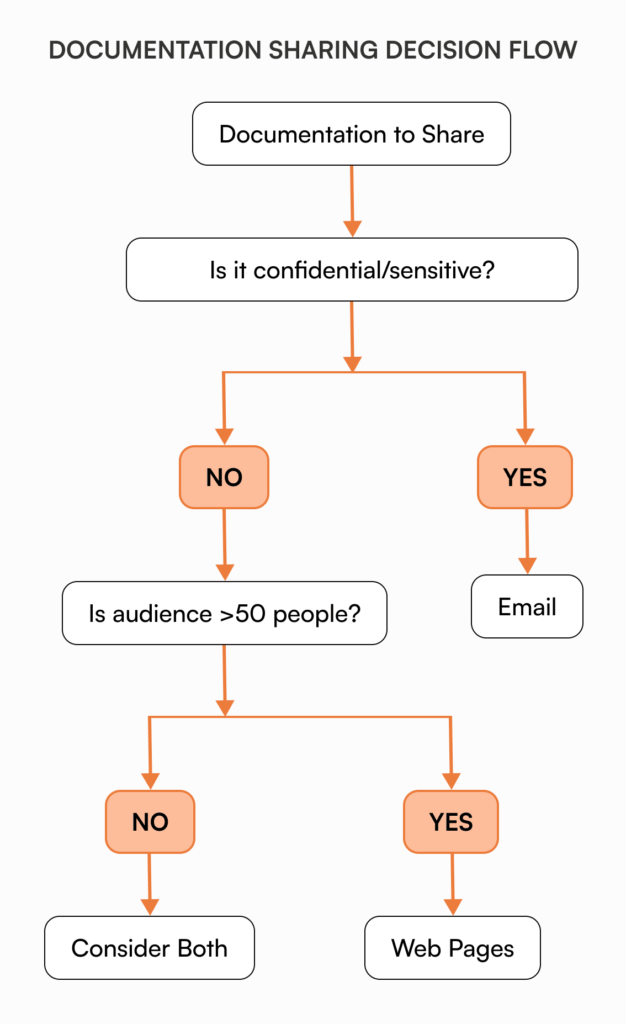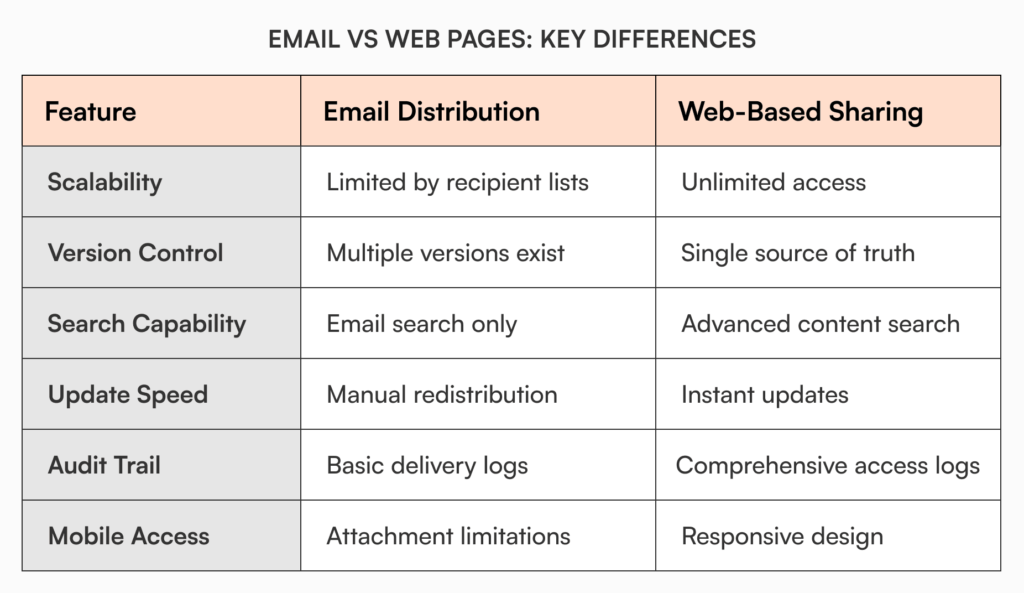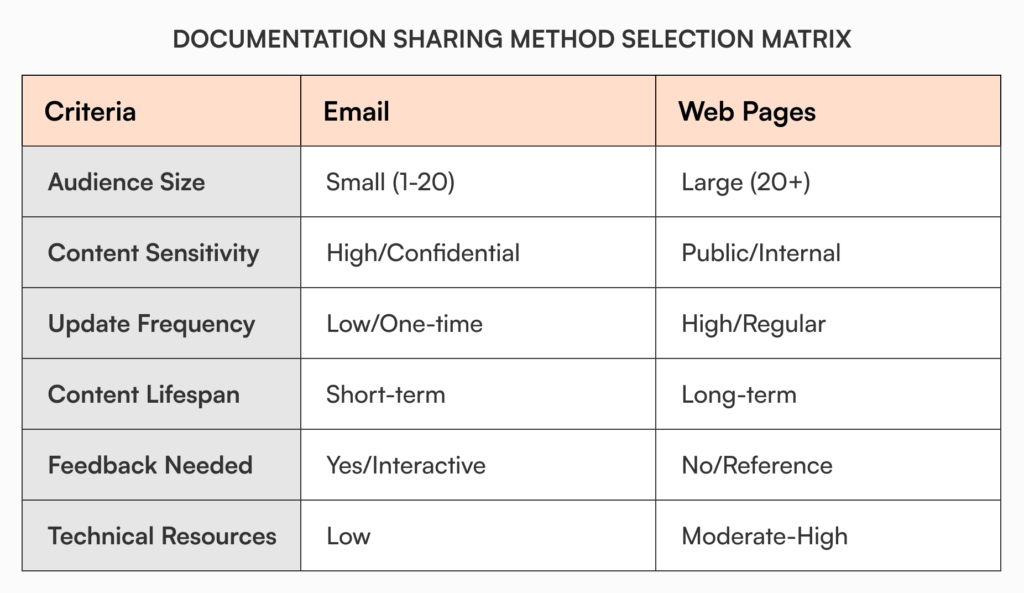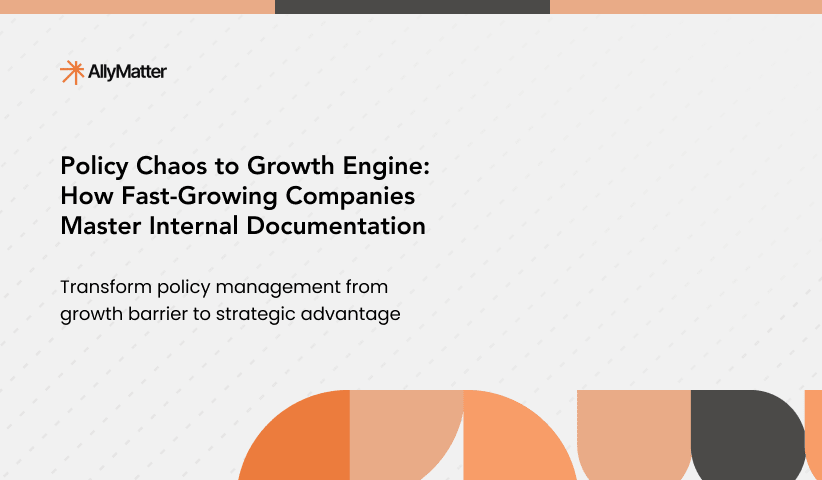Your marketing team just published updated brand guidelines on the company web portal, but half the sales team is still using the old version they received via email three months ago. Meanwhile, your HR director spent an hour yesterday explaining why she can’t share the confidential compensation analysis on the public web page.
Documentation sharing decisions fundamentally impact how efficiently your organization operates. For growing companies, choosing between email distribution and web-based platforms isn’t just about convenience; it’s about building scalable knowledge systems that support business growth without creating operational chaos.

When email serves targeted documentation sharing needs
Email remains the preferred documentation sharing method for specific scenarios, particularly when dealing with sensitive information and limited audiences.
Confidential documentation for specific stakeholders: Some documentation requires controlled sharing with defined recipients only. When your finance team distributes quarterly budget analysis to department heads, email provides direct delivery with clear recipient tracking. Web pages, even password-protected ones, may not offer the same security level for highly sensitive information.
Michael, a CFO at a 150-person manufacturing company, discovered this when sharing confidential acquisition documents. The documentation needed immediate attention from five specific executives, and email ensured secure, trackable delivery without risking broader organizational access through web-based sharing.
Targeted audience engagement: Email excels when documentation sharing requires immediate feedback from specific team members. Draft policy documents often benefit from direct email distribution to subject matter experts who can provide targeted input through direct responses, creating an interactive dialogue that refines documentation before broader web-based sharing.
Time-sensitive documentation updates: Urgent procedural changes or critical policy updates warrant immediate email notification. When documentation affects ongoing operations, email provides direct alerts ensuring recipients see time-sensitive information without relying on them to check web pages or centralized repositories.
Bypassing organizational access barriers: Some team members face restrictions accessing certain web platforms due to security policies, network limitations, or firewall restrictions. Email documentation sharing sidesteps these barriers, ensuring essential information reaches all intended recipients regardless of web access limitations or technical constraints.
Simplicity for resource-constrained scenarios: When lacking technical expertise or resources to set up web pages, email offers straightforward documentation sharing that doesn’t require specialized knowledge or platform management. This approach works particularly well for smaller teams or one-time document distribution needs.
Web-based platforms for scalable documentation sharing
Growing organizations quickly discover that email-heavy documentation sharing creates bottlenecks and version control nightmares, particularly when scaling beyond 100 team members.
Broad audience documentation access: Company-wide policies, standard operating procedures, and general guidelines benefit from web-based sharing that serves unlimited users simultaneously. Unlike email distribution lists requiring constant maintenance, web pages provide scalable access that grows with your organization without additional distribution overhead.
According to Gartner research, 47% of digital workers struggle to find the information needed to effectively perform their jobs. Web-based documentation sharing addresses this challenge by making information discoverable through organized navigation, search functionality, and persistent availability.
Long-term documentation accessibility and discoverability: Documentation intended for ongoing reference requires permanent, easily accessible web hosting rather than burial in email threads. Employee handbooks, compliance procedures, and technical specifications need consistent availability that survives personnel changes and organizational restructuring.
Web pages offer superior organization capabilities compared to email attachments. Documents can be categorized, indexed, and cross-referenced in ways that make navigation intuitive and information discovery efficient for large audiences.
Real-time documentation updates: Web-based platforms enable live documentation updates that immediately reflect across all access points. When policies change or procedures evolve, teams access current information without the version confusion created by multiple email distributions containing outdated attachments.
This dynamic updating capability becomes crucial as organizations grow. According to McKinsey research, employees spend nearly 20% of their workweek looking for internal information or tracking down colleagues for help. Web-based documentation sharing with real-time updates eliminates much of this productivity drain.
Interactive and multimedia documentation capabilities: Modern documentation often requires rich media elements, embedded tools, and interactive features that email cannot support effectively. Training materials, process workflows, and comprehensive guides benefit from video integration, interactive charts, and dynamic content that enhances user understanding.
Web pages support responsive design ensuring documentation displays properly across devices, from desktop computers to mobile phones, making information accessible regardless of how team members access it.
Search engine optimization and internal discoverability: Web-based documentation sharing enables powerful search capabilities that help team members find specific information quickly. Advanced search functionality, intelligent tagging, and content categorization transform scattered information into easily discoverable knowledge assets.
For growing companies, internal search capabilities become increasingly important as documentation volume expands. Web platforms can implement sophisticated search algorithms that understand context and user intent, dramatically reducing time spent hunting for information.
Security considerations in documentation sharing methods
Documentation sharing security requirements significantly influence platform selection, particularly for growing companies managing increasingly complex and sensitive information assets.
Access control and permission management: Email provides basic security through recipient selection, but lacks sophisticated access controls for complex organizational structures. Web-based platforms offer granular permissions that align with organizational roles, departments, and project involvement.
Modern web platforms enable document-specific permissions, temporary access grants, and automated access reviews that scale with organizational growth. This granular control becomes essential when sharing documentation across departments with varying security clearances.
Audit trails and compliance requirements: Regulatory environments demand comprehensive documentation trails showing who accessed what information and when. While email provides basic delivery confirmation, web-based platforms offer detailed audit logs that support compliance requirements and security investigations.
According to a PwC survey, about 35% of risk executives view compliance and regulatory risk as the top barrier to their company’s growth. Web-based documentation sharing with comprehensive audit capabilities helps address these concerns while supporting business expansion.
Data protection and encryption standards: Growing organizations must ensure documentation sharing methods meet enterprise security standards. Web-based platforms typically provide end-to-end encryption, secure data transmission, and backup systems that often exceed email security capabilities, particularly for sensitive business information.

Content-driven documentation sharing decisions
Different documentation types require different sharing approaches based on their intended use, audience scope, and update frequency.
Policy and compliance documentation: Company-wide policies, regulatory procedures, and compliance guidelines require web-based sharing for consistency and version control. Email distribution creates confusion when policies change, as teams may reference outdated versions stored across multiple inboxes rather than accessing current web-based versions.
Project-specific documentation: Temporary project documentation or client-specific information may warrant targeted email sharing to defined stakeholders. However, even project documentation benefits from web-based storage with controlled access, ensuring relevant team members can find information without email archaeology while maintaining appropriate security boundaries.
Training and reference documentation: Employee onboarding materials, process guides, and reference documentation require web-based sharing for consistency and accessibility. According to research from the Society for Human Resource Management, it takes new hires 8-12 months to achieve full productivity in professional roles. Email-based documentation sharing significantly extends this timeline by creating information discovery barriers and version confusion.
Emergency and critical update documentation: Crisis management protocols and urgent policy changes need immediate sharing through multiple channels. While email provides direct notification, critical procedures should also exist on easily accessible web pages for ongoing reference during emergency situations when email systems might be overwhelmed or inaccessible.
Building effective documentation sharing strategies
Successful documentation sharing requires strategic alignment with organizational growth patterns, security requirements, and operational workflows.
Audience size and scope considerations: Small, defined audiences often work well with email sharing, while broader organizational audiences benefit from web-based platforms. However, consider future scaling needs when making sharing decisions. What works for 50 employees may create bottlenecks at 500 employees.
Documentation lifecycle management: Consider how long documentation remains relevant and how frequently it requires updates. Short-term, static documentation may work through email sharing, while living documents need web-based platforms that support ongoing maintenance, version control, and collaborative editing.
Integration with organizational workflows: Effective documentation sharing integrates seamlessly with existing business processes. Consider how team members currently access information and choose sharing methods that enhance rather than disrupt established workflows while supporting future scaling requirements.

Technology considerations for documentation sharing platforms
The right documentation sharing technology grows with your organization while maintaining usability, security, and performance standards.
Web platform scalability and performance: Web-based documentation sharing systems must handle increasing users, content volume, and concurrent access without performance degradation. Evaluate platforms based on current needs while ensuring they support anticipated growth trajectories and peak usage patterns.
Search and discovery capabilities: As documentation volume grows, finding specific information becomes increasingly challenging. Web platforms with advanced search functionality, intelligent tagging, and AI-powered content discovery ensure team members can locate needed documentation efficiently, regardless of organizational size or content complexity.
Mobile responsiveness and remote access: Modern documentation sharing must support distributed teams and mobile access patterns. Web platforms should provide consistent functionality across devices and locations, ensuring documentation remains accessible regardless of work environment or device constraints.
Measuring documentation sharing effectiveness
Track key metrics to ensure your documentation sharing approach supports organizational objectives and team productivity.
Access patterns and usage analytics: Web-based platforms provide detailed analytics about how team members access documentation, revealing bottlenecks, popular content, and underutilized resources. This data helps optimize sharing methods and content organization for maximum effectiveness.
Related reading: Using Knowledge Base Analytics to Predict Information Needs
Time-to-information metrics: Measure how quickly team members can find needed documentation using current sharing methods. Long search times indicate sharing method problems that impact productivity and operational efficiency, whether through email archaeology or poorly organized web platforms.
Version control and accuracy tracking: Monitor documentation version accuracy across your organization. Multiple versions of the same documentation indicate sharing method problems that create confusion and operational risks, particularly when mixing email distribution with web-based updates.
Why strategic documentation sharing drives operational efficiency
Effective documentation sharing forms the foundation of scalable business operations, directly impacting team productivity and organizational efficiency as companies grow beyond traditional email-based distribution methods.
AllyMatter’s knowledge management platform addresses the complex documentation sharing challenges facing growing organizations. The platform combines the security benefits of controlled email distribution with the scalability and accessibility advantages of modern web-based systems.
With granular access controls and comprehensive audit trails, sensitive documentation reaches intended stakeholders through secure web-based sharing while maintaining enterprise-grade security standards. Advanced search capabilities and intelligent organization reduce the time teams spend hunting for information across email threads and scattered attachments.
The platform’s version control eliminates confusion from multiple documentation versions, while role-based web access ensures appropriate information sharing as organizations scale and evolve. Real-time updates keep all team members aligned with current procedures without the distribution overhead of email-based sharing.
Ready to transform your documentation sharing strategy beyond email limitations? Join our waitlist.
Frequently asked questions
How do we determine whether documentation should be shared via email or web pages?
Evaluate each documentation type based on audience size, sensitivity level, update frequency, and intended lifespan. Confidential, targeted documentation often works well through email sharing, while broad-access, frequently updated documentation benefits from web-based platforms. Create a decision matrix considering security requirements, audience scope, and maintenance needs.
What security measures should we implement when moving from email to web-based documentation sharing?
Implement role-based access controls, comprehensive audit logging, and enterprise-grade encryption for sensitive documentation. Establish clear guidelines for information classification and train team members on web platform security features. Regular access reviews ensure permissions remain appropriate as organizational roles evolve.
How can we manage the transition from email-based documentation sharing without disrupting operations?
Begin with new documentation using web-based sharing while gradually migrating critical existing materials. Provide clear communication about information locations and offer comprehensive training on web platform navigation and search techniques. Most teams adapt within 2-4 weeks when the productivity benefits become apparent through daily use.
What integration capabilities should we prioritize in web-based documentation sharing platforms?
Focus on integrations with existing communication tools, project management systems, and business applications. Seamless workflow integration reduces adoption friction and increases team engagement with web-based documentation sharing systems while maintaining familiar user experiences.
How do we handle team members who prefer email attachments over web-based documentation access?
Address concerns through training that demonstrates web platform advantages like always-current information, powerful search capabilities, and mobile access. Show how web-based sharing eliminates email attachment version confusion and reduces time spent hunting through old messages. Provide support during the transition period while maintaining clear expectations about platform adoption.


